The population of goats in the UK had risen steadily in recent years, and there is a high chance that a vet in general practice will have something to do with these fascinating and characterful farmed species. The UK goat sector is one of the most diverse within the agricultural setting, being comprised of three main commercial elements: dairy, meat and fibre; with the remainder falling into the varied categories of pedigree and/or show stock, public attraction stock, small holder stock and those kept exclusively as pets. The general vet practitioner has to be aware of the varied circumstances, management practices and surroundings in which these animals are kept.
The clinical examination
What is ‘normal’?
Goats have evolved as browsers rather than grazers, unlike our other common domesticated ruminants, and given free choice they would preferentially range over large areas to consume their pick of many different plant species to ensure a satisfactory vitamin, mineral and protein intake (Matthews, 2009). Goats will refuse to eat plants that have been contaminated with the scent of their own species, urine or faeces, and in this way greatly reduce parasite ingestion. This, coupled with their browsing inclination, and their ‘heads up’ approach to feeding, avoids the bulk of pasture-based parasites, which tend not to climb above 15 cm. However, this means that goats have not evolved the ability to develop an acquired immunity to gastrointestinal parasites (Matthews, 2009). In intensive systems, goats remain ‘fussy’ eaters and can distinguish between bitter, salt, sweet and sour tastes and will refuse seemingly similar batches of feed because of slight variations in flavour. Goats do have a higher tolerance for bitter tasting feeds, probably the result of their browsing ability and foraging of bark, leaves and woody shrubs (Matthews, 2009).
Being prey species, neonatal goats will look to hide and can freeze in one spot at the sound of danger in the hope whatever it is may pass them by (Matthews, 2009). Kids will generally huddle together; a kid in isolation is unusual and should be investigated. Goats also have a well-defined social hierarchy with a clear dominance order. For this reason, groups should be kept as stable as possible, as disturbance of this order can lead to bullying behaviours and misadventure accidental injuries.
Why perform a clinical examination?
In order to diagnose, it is almost always necessary and invariably useful to clinically examine the animal. The information gleaned through clinical examination can then be augmented with information from the owner/farmer and other observations (husbandry, environment, behaviours and interactions with herd mates). Some owners may resist calling the vet for a clinical examination. The reasoning behind this can be varied, from costs and economics, lack of experience as to when to know to call for help, through to simply not thinking it is necessary. However, it can be challenging to rely on owner histories alone, particularly if they lack clinical and/or livestock experience as the relevant importance (or not) that they may place on things they are, or perhaps aren't, seeing can certainly skew clinical decision making. In short, it is always preferable to clinically examine the goat in its kept environment or at the practice so that the goat's interactions with its kept environment can be assessed.
The clinical history
Additional vital information can be extracted from owners/farmers with careful detailed and meticulous questioning. The history can add detail to the clinical findings, can identify avenues to expand examinations and suggest areas for further investigation. The history can also identify potentially important details in the animal's management, husbandry practices, disease status, previous issues, herd level concerns and even influences from other species that may be kept in close proximity or on the same holding/within the same environment or management structure (Dustan, 2021).
Where to conduct the clinical examination
The clinical examination should be performed in an area that is safe for both the patient and clinician, with enough space for adequate restraint. There should be good light (or alternative means of light be made available), and the floor surface should be non-slippery and preferably dry. Goats are very sociable creatures and can become distressed if separated from the sight and sound of their herd mates. It can be useful to have a ‘pen-mate’ alongside the patient to keep the goat calm if space allows. Figure 1 shows a goat being restrained for clinical examination.
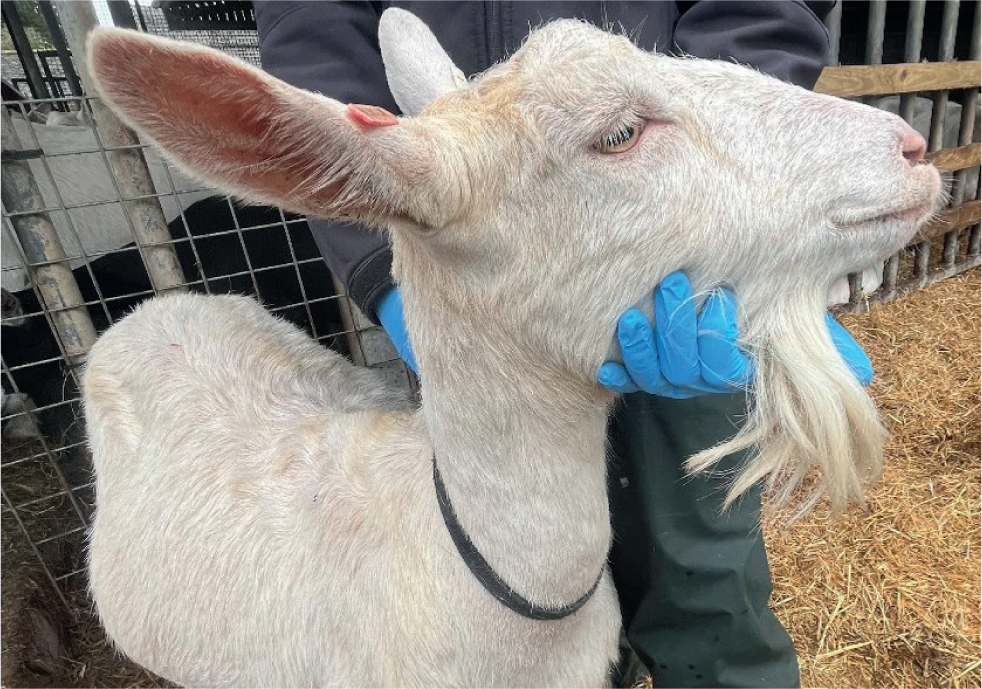
Consider that the goat(s) may need to be moved to a more suitable location for examination, and in these instances it is worth bearing in mind that they have excellent peripheral vision, they prefer to move towards light areas and that they have a natural herding instinct, but because of their strong social bonds and hierarchies they may choose to follow or conversely refuse to follow certain goats and can easily become stressed or frightened if moved without due care and attention (Gasgoigne and Dustan, 2018). The goat(s) can then become difficult to handle and catch and they will actively look to escape.
Goats differ from other small ruminants in that they do not tolerate significant physical restraint, often becoming more agitated and stressed, particularly if turned over onto their haunches (Dustan, 2023). Maintaining the presence of a herd-mate can help to keep the goat calm during necessary restraint as mentioned previously. However tempting, holding and handling by the horns should be avoided as the goat resents this handling and can become head shy and use the horns against the handler (Harwood and Mueller, 2018). To enable adequate restraint for a thorough clinical examination, it is often sensible to have an experienced goat handler on hand to offer assistance. When dealing with small numbers of goats, pet goats or those belonging to smallholders, the goats will be used to wearing neck collars and restraint can often be achieved by having a person familiar to the goats hold them by the neck collar with a hand placed under the chin to support. By positioning the goat alongside a penside or building wall, or backing the struggling goat into a corner, the range of lateral sway the goat can achieve can be limited and the examination can be performed in a safe manner (Dustan, 2023). On larger commercial enterprises, animal handling equipment is frequently available, which may include race, hurdles, pens and some form of crush/crate in which the goat can be safely restrained. However the goat is restrained, it is important to minimise the chance of accidental injury if the goat decides to try and escape.
Box 1:Examples of history areas of interestUnit, environment and husbandry history:
- Type of business or unit (dairy, meat, fibre, pedigree breeding stock)
- How long have the owners kept goats? What are the experience levels with regards to goat keeping on the farm? Is the current venture new or well-established?
- Stock sourcing policy: open or closed. If closed – is this robust? Does this include breeding bucks? Are there risks of breach? If open – how are animals sourced? What protocols are in place to ensure isolation periods and quarantine measures undertaken?
- Does the unit have any other purpose or livestock: for example does a dairy goat farm sit alongside a beef finishing unit? Does a goat meat producer share grazing with a lowland sheep enterprise run on the same farm? Does a petting zoo operate on a goat fibre production enterprise?
- What are the current, recent and past disease or management problems that have affected the farm? These may include seasonal issues, perhaps an outbreak of neonatal scour during the previous kidding period, an outbreak of pneumonia during an inclement period of weather
- Have there been any local disease outbreaks or concerns? For example, has a contiguous dairy cattle farm recently been placed under restrictions due to disclosure of a TB reactor…
History of the individual or group of interest:
- Signalment: age, sex (castrated), breed, home-bred or bought-in, stage of production
- Main concern/reason for examination: what is the duration of the signs? Has there been progression? Are there periods of normality? Is behaviour being affected? Are others in the group affected?
- History of any recent change: management change, stage of production change, for example a milking goat that has just been dried off, nutritional or diet make-up change, new goats added to the group or animals removed from the group, any building or environmental/husbandry change of the animal/group
- Production data for the animal/group: daily milk yield and change, daily liveweight gain
- Health history of the individual animal or group, including recent routine treatments or medications, vaccinations
- What treatment or interventions have been performed so far? What response has been seen to these? How long again were interventions made? Could interventions be masking any clinical findings?
Assistance of experienced handlers
As described previously, it is often helpful to have someone that is used to dealing with goats on hand to help. Goats can be calmer in the presence of a familiar human in which they have trust. In any case, anyone that assists the examination should be quiet, calm, confident and gentle yet firm, so that the goat can be safely and appropriately handled for the examination.
Clinical examination techniques
There are many different ways in which a clinical examination can be conducted, which only serves to illustrate the point that no one way is correct or indeed best. Whatever method is preferred, it should be thorough, repeatable, simple and time effective to perform so that the same method can be repeated time and time again so that it becomes natural and instinctive. In this way, it is unlikely the clinician will miss anything, and it can help them recall key findings when completing documentation and it can be shared with others, which can be useful in clinical discussions or when describing and relaying findings to owners and farmers whilst summarising the examination and discussing treatment options.
The author's preferred approach has always been to start from a distance, assessing the goat's general stance, demeanour and condition (Figure 2). This often directs the first questions to the owner/farmer about husbandry, herd health, past and recent issues. It is also a good opportunity to ascertain key information such as vaccination status.
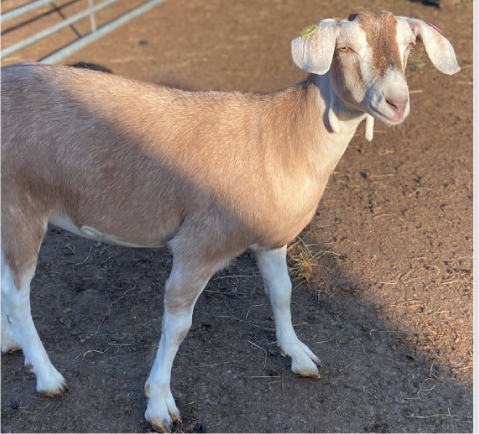
The clinician should then take the temperature of the goat, while all the time observing the goat's condition, standing position and posture/movements. Once up close with the goat, often more apparent questions come to mind, perhaps relating to the skin or coat condition, presence of ectoparasites or body condition of the animal, or presence or absence of diarrhoea/faecal staining of the perineum or other discharge apparent. This enables the history taking to become more focussed.
Once ascertained whether the goat is pyrexic or not, the author returns to the head of the goat and begins a ‘head to tail’ focussed clinical examination as follows.
Head
The goat usually holds its head in an upright position, level, with its ears pricked (breed dependent) and alert. Goats have eyes with horizontal pupils (Figure 3), and the eyes should be clear with no ocular discharge or eyelid drooping. Pay careful attention to the position and movements of the eye as goats are extremely susceptible to conditions such as listeriosis, probably because of their inquisitive nature, which may bring them into more frequent contact with the bacteria. Goats are more likely to have micro-trauma in the oral cavities. Listeriosis can lead to ocular defects as well as areas of facial paralysis.
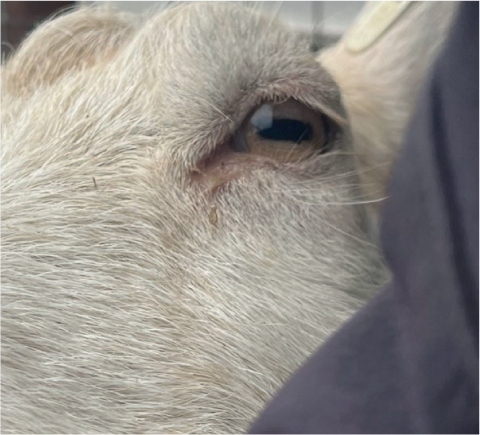
Goats also commonly suffer from facial abscesses and sialocoeles, again probably linked back to their feeding behaviours. The practitioner should be aware of the presence of anatomical variances such as wattles, which can contains cysts, the infectious bacterial disease caseous lymphadenitis, and even that it is more common to encounter the geriatric goat in practice which may suffer with dental associated abscesses; facial swellings are common and identifying the cause is important.
The nares should be equal and clean with no discharge. The muzzle and mouth is usually clean and the incisor teeth should meet the dental pad in equal alignment. Over and under-shot jaws can be common and can lead to dental issues as well as general difficulties with mastication. Be sure to palpate the jaw and skull in general to gain an appreciation of any swellings, whether these are soft tissue or bony and associated with any specific anatomy, for example the lymph nodes, salivary glands or maxillary/mandibular joint. Check the colour of the mucous membranes and sclera of the eye to assess anaemia, blood oxygenation status, dehydration and even whether the goat may be jaundiced, toxic etc.
While assessing the head, also listen and watch for eructation and any unusual sounds or difficulty breathing, monitoring for tremors or unusual movements.
Neck, chest, spine and forelimbs
The vet should run their hands over all parts and points of the goat, particularly down the neck, limbs and along the spine, checking for lumps, swellings, heat or resentment to palpation. This can also provide useful information on goat body condition and it should be noted that many breeds of goats store a lot of their body fat internally, making them difficult to body condition score in a conventional lumbar/pelvic scoring manner. In fact, a more accurate way of body condition scoring goats is to score multiple different locations, as detailed by Mueller and Harwood (2018) to include pectoral, thoracic, lumbar and pelvic scores.
At this point, the vet should auscultate the heart and lung fields, determine a heart and respiratory rate, whilst also assessing respiratory effort and noting unusual grunts, inspiratory/expiratory noise, crackles and wheezes. It can be useful to perform a withers pinch as a crude measure of cranial abdominal pain but this tends to be a less useful indicator in goats than in cattle.
Box 2:Common clinical parameters of the goat
| Temperature (°C) | 38.6–39.8 (average 39.3) |
| Heart Rate (bpm) | 70–95 |
| Respiration (breaths/m) | 15–30 (adults) |
| 20–40 (kids) | |
| Rumination (cycles/m) | 1–1.5 |
| Weight (kg) | 55–105 kg (adult dairy doe) |
| 75–120 kg (adult dairy buck) | |
| 35–55 kg (adult angora doe) | |
| 50–70 kg (adult angora buck) | |
| 22–27 kg (adult pygmy doe) | |
| 28–32 kg (adult pygmy buck) | |
| Age at puberty | 4–5 months |
Adapted from: Matthews (2009)
The vet should pick up each forelimb in turn, paying particular attention to the shifting of weight, the goat's willingness to pick up the foot, perform manipulation of each joint and take a detailed look at the claw health, length, heel height and for any foot health conditions. Goats have particularly fast growing claw horn and in the common management systems are susceptible to increased heel height and excessive toe length, which if uncorrected can lead to severe functional lameness. Figure 4 shows a goat on its knees clearly identifying it as an animal that needs further examination.
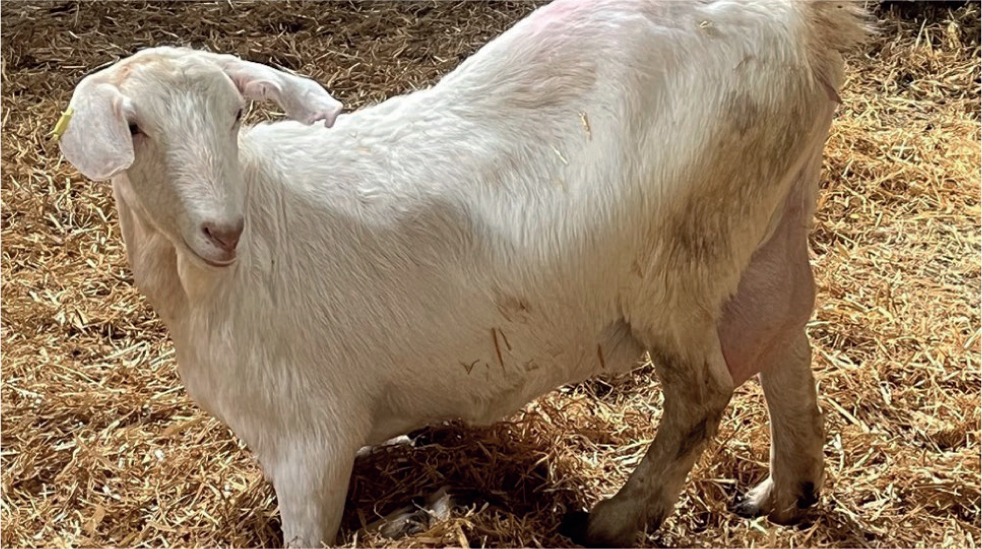
Abdomen and lumbar spine
Auscultation and percussion of the abdominal cavity is particularly important, on both the left and right hand sides. Listening for ruminal turnover and rate, as well as caecal emptying and unusual areas of tympanic resonance that may be associated with distended gastro-intestinal viscera or displacements. Palpation can help to determine whether the abdomen is tender, particularly in the neonate/growing kid where abdominal musculature can be tense and guarded. Swellings are of note, particularly if associated with lymph nodes, umbilical area, prepuce or udder and could be indicative of infection or herniation.
Urolithiasis is very common in male goats, particularly castrated pet goats which commonly get overfed on high concentrate-based diets. Prompt clinical examination and history taking are essential to the outcomes of these cases and the clinician will need to be alert to signs of abdominal straining, which can be mistaken for constipation (which is rare), when actually the goat is trying to urinate. The blocked goat will often be depressed, anorexic and become agitated with pain and struggle to lie comfortably. Their gait can often become stilted and uneasy as they shift from side to side in pain. Tooth grinding is common as a non-specific response to pain.
Hindlimbs, pelvis, rectum/vagina
Lift the limbs in turn in the same manner as the forelimbs, again paying particular attention to the joints and point of each limb. The pelvis should be assessed for stability and indicators of cleanliness, then looking at the rear end generally for presence of discharge that may have been missed whilst taking a temperature. The colour of the vulval lips can be assessed in females, along with the supramammary lymph nodes, and the lymph nodes of the hind limbs should be palpated. Figure 5 shows the rear of the goat including the udder.
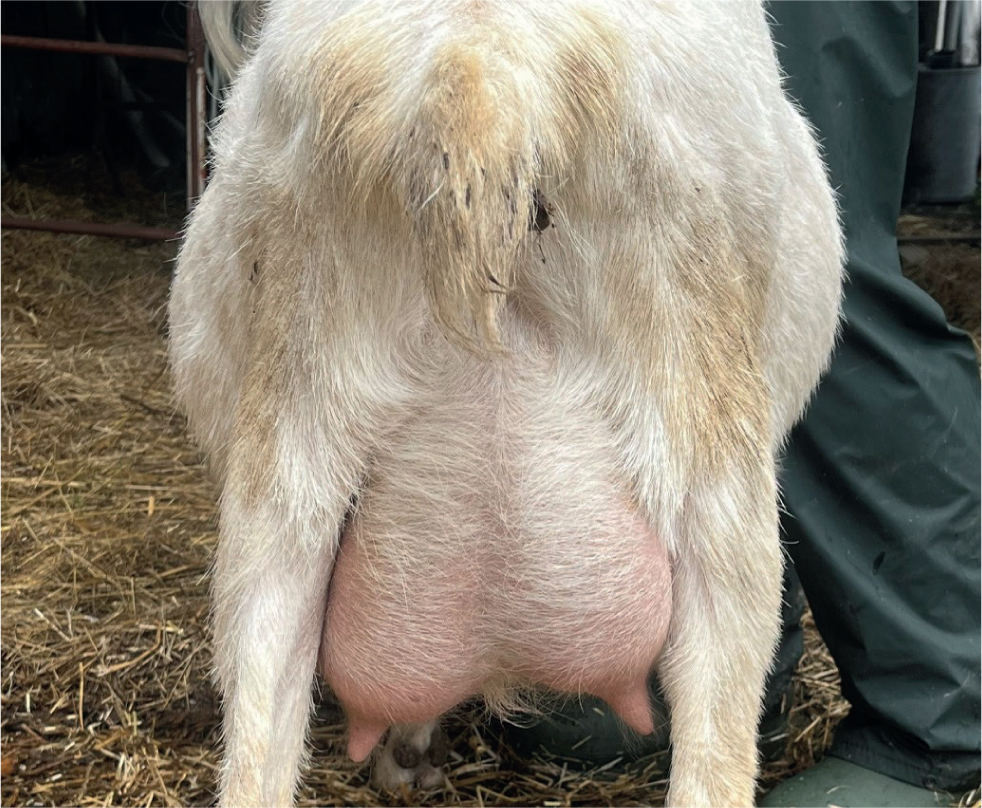
Examination summary
Having been head to toe, the vet should stand back, and potentially release the goat if restrained within a small pen, and go through the clinical findings with the owner drawing all the various findings together to build a clinical picture. This often leads to further questions for the owner and also formulates a list of potential differential diagnoses, which can then prompt further questions or diagnostic tests or further investigations and/or information required. It is often useful to observe the goat in this period to assess how the goat is reacting to the examination and its sudden release from restraint. The owners can often explain whether the goat is acting our of character, which can be invaluable when trying to interpret the goat's behaviour within these restricted environments.
Finally the clinical examination is summarised and this invariably leads to a plan being formulated for that individual or groups' future management. It is worth bearing in mind the likely prognosis and instigating appropriate follow up, progress checks and re-examinations as and when, if necessary.
Conclusions
The clinical examination is a crucial element to the veterinarians' ability to accurately diagnose and treat our animal patients. Goats are particularly inquisitive, they are agile climbers, evolutionary browsers and notable characters such that their clinical examination can present significant challenges to the attending vet and the investigative nature of the history taking can help enormously in the interpretation of the clinical findings (Dustan, 2021).
The clinical examination should be as thorough as necessary, with the goat restrained in a manner which exerts only as much restraint as is necessary. The approach and technique should be repeatable and so with time and practice the approach is ingrained and the process will be unlikely to miss anything to the benefit of our goat patients and clients alike.


